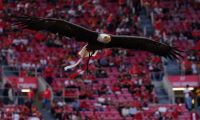
Origin and development
The 1959 Corvette Sting Ray concept and 1960 XP-700 show car in the front and the 1963 Corvette convertible and fastback in the back.
The 1963 Sting Ray production car's lineage can be traced to two separate GM projects: the Q-Corvette, and Bill Mitchell's racing Sting Ray. The Q-Corvette exercise of 1957 envisioned a smaller, more advanced Corvette as a coupe-only model, boasting a rear transaxle, independent rear suspension, and four-wheel disc brakes, with the rear brakes mounted inboard. Exterior styling was purposeful, with peaked fenders, a long nose, and a short, bobbed tail.
Meanwhile, Zora Arkus-Duntov and other GM engineers had become fascinated with mid and rear-engine designs. Duntov explored the mid/rear-engine layout with the lightweight, open-wheel, single-seat CERV I concept of 1959. A rear-engined Corvette was briefly considered during 1958–60, progressing as far as a full-scale mock-up designed around the Corvair's entire rear-mounted power package, including its air-cooled flat-six, as an alternative to the Corvette's usual water-cooled V8. By the fall of 1959, elements of the Q-Corvette and the Sting Ray Special racer would be incorporated into experimental project XP-720, which was the design program that led directly to the production 1963 Corvette Sting Ray. The XP-720 sought to deliver improved passenger accommodation, more luggage space, and superior ride and handling over previous Corvettes.
While Duntov was developing an innovative new chassis for the 1963 Corvette, designers were adapting and refining the basic look of the racing Sting Ray for the production model. A fully functional space buck (a wooden mock-up created to work out interior dimensions) was completed by early 1960, production coupe styling was locked up for the most part by April, and the interior, instrument panel included, was in place by November. Only in the fall of 1960 did the designers turn their creative attention to a new version of the traditional Corvette convertible and, still later, its detachable hardtop. For the first time in the Corvette's history, wind tunnel testing influenced the final shape, as did practical matters like interior space, windshield curvatures, and tooling limitations. Both body styles were extensively evaluated as production-ready 3/8-scale models at the Caltech wind tunnel.
The vehicle's inner structure received as much attention as the aerodynamics of its exterior. Fiberglass outer panels were retained, but the Sting Ray emerged with nearly twice as much steel support in its central structure as the 1958–62 Corvette. The resulting extra weight was balanced by a reduction in fiberglass thickness, so the finished product actually weighed a bit less than the old roadster. Passenger room was as good as before despite the tighter wheelbase, and the reinforcing steel girder made the cockpit both stronger and safer.

Design and engineering
1963 Corvette Sting Ray Coupe
The first-ever production Corvette coupe sported a fastback body with a long hood and a raised windsplit that ran the length of the roof and continued down the back on a pillar that bisected the rear window into right and left halves. The split backlite is usually attributed to Mitchell, who claimed to have been inspired by the 57SC Bugatti "Atlantique" coupe. The feature actually predated both the C2 Corvette and Bob McLean's Q-Corvette, having been used by Harley Earl on both his Oldsmobile Golden Rocket show car and his own more traditional design studies for the C2 Corvette, some of which had progressed to full-scale models.[9] Earl's inspiration was said to have been an Alfa Romeo coupe with a body by Scaglione shown at the 1954 Turin Auto Show.
Quad headlamps were retained but newly hidden – the first American car so equipped since the 1942 DeSoto. The lamps were mounted in rotating housings that blended with the sharp-edged front end when "closed". Hidden headlamps would be a feature of the Corvette until the C6 model debuted in 2005. Coupe doors were cut into the roof, which made entry/exit easier in such a low-slung closed car. Faux vents were located in the hood and on the coupe's rear pillars; functional ones had been intended but were cancelled due to cost considerations.

1963 Corvette Sting Ray interior
The Sting Ray's interior carried a re-interpretation of the twin-cowl Corvette dash motif used since 1958, but a more practical one incorporating a roomy glovebox, an improved heater, and the cowl-ventilation system. A full set of round gauges included a huge speedometer and tachometer. The control tower center console returned, somewhat slimmer but now containing the clock and a vertically situated radio. Luggage space was improved as well, although due to the lack of an external trunklid, cargo had to be loaded behind the seats. The spare tire was located at the rear in a drop-down fiberglass housing beneath the gas tank (which now held 20-US-gallon (76-litre; 17-imperial-gallon) instead of 16-US-gallon (61 l; 13 imp gal). The big, round deck emblem was newly hinged to double as a fuel-filler flap, replacing the previous left-flank door.
Though not as obvious as the car's radical styling, the new chassis was just as important to the Sting Ray's success. Maneuverability was improved thanks to the faster recirculating ball, or "Ball-Race", steering, and a shorter wheelbase. The latter might ordinarily imply a choppier ride, but the altered weight distribution partly compensated for it. Less weight on the front wheels also meant easier steering, and with some 80 additional pounds on the rear wheels, the Sting Ray offered improved traction. Stopping power improved, too. Four-wheel cast-iron 11-inch drum brakes remained standard but were now wider, for an increase in effective braking area. Sintered-metallic linings, segmented for cooling, were again optional. So were Al-Fin brake drums, which not only provided faster heat dissipation (and thus better fade resistance) but less unsprung weight.[10] Power assist was available with both brake packages. Evolutionary engineering changes included positive crankcase ventilation, a smaller flywheel, and an aluminum clutch housing. A more efficient alternator replaced the old-fashioned generator.
1963 Corvette Sting Ray Convertible & Coupe
The independent rear suspension created by Duntov was derived from the CERV I concept, and included a frame-mounted differential with U-jointed half-shafts tied together by a transverse leaf spring.[11] Rubber-cushioned struts carried the differential, which reduced ride harshness while improving tire adhesion, especially on rougher roads. The transverse spring was bolted to the rear of the differential case. A control arm extended laterally and slightly forward from each side of the case to a hub carrier, with a trailing radius rod mounted behind it. The half-shafts functioned like upper control arms. The lower arms controlled vertical wheel motion, while the trailing rods took care of fore/aft wheel motion and transferred braking torque to the frame. Shock absorbers were conventional twin-tube units. Considerably lighter than the old solid axle, the new rear suspension array delivered a significant reduction in unsprung weight, which was important since the 1963 model would retain the previous generation's outboard rear brakes. The new model's front suspension would be much as before, with unequal-length upper and lower A-arms on coil springs concentric with the shocks, plus a standard anti-roll bar. Steering remained the conventional recirculating-ball steering design, but it was geared at a higher 19.6:1 overall ratio (previously 21.0:1). Bolted to the frame rail at one end and to the relay rod at the other was a new hydraulic steering damper (essentially a shock absorber), which helped soak up bumps before they reached the steering wheel. What's more, hydraulically assisted steering would be offered as optional equipment for the first time on a Corvette – except on cars with the two most powerful engines – and offer a faster 17.1:1 ratio, which reduced lock-to-lock turns from 3.4 to just 2.9.

Drivetrains were carried over from the previous generation, comprising four 327 cu in (5,360 cc) small block V8s, three transmissions, and six axle ratios. Carbureted engines came in 250 hp (186 kW), 300 hp (224 kW), and 340 hp (254 kW) versions. As before, the base and optional units employed hydraulic lifters, a mild camshaft, forged-steel crankshaft, 10.5:1 compression, single-point distributor, and dual exhausts. The 300-bhp engine produced its extra power via a larger four-barrel carburetor (Carter AFB instead of the 250's Carter WCFB), plus larger intake valves and exhaust manifold. Again topping the performance chart was a 360 hp (268 kW) fuel-injected V8, available for an extra $430.40. The car's standard transmission remained the familiar three-speed manual, though the preferred gearbox continued to be the Borg-Warner manual four-speed, changing over to the Muncie M20 during the 1963 model year, delivered with wide-ratio gears when teamed with the base and 300-bhp engines, and close-ratio gearing with the top two powerplants. Standard axle ratio for the three-speed manual or two-speed Powerglide automatic was 3.36:1. The four-speed gearbox came with a 3.70:1 final drive, but 3.08:1, 3.55:1, 4.11:1, and 4.56:1 gearsets were available. The last was quite rare in production, however.

1963 Corvette with split rear window
Corvette's designers and engineers – Ed Cole, Duntov, Mitchell, and others – knew that after 10 years in its basic form, albeit much improved, it was time to move on. By decade's end, the machinery would be put into motion to fashion a fitting successor to debut for the 1963 model year. After years of tinkering with the basic package, Mitchell and his crew would finally break the mold of Harley Earl's original design once and for all. He would dub the Corvette’s second generation "Sting Ray" after the earlier race car of the same name. The C2 was designed by Larry Shinoda (Pete Brock was also instrumental on the C2) under the direction of GM chief stylist Bill Mitchell. Inspiration was drawn from several sources: the contemporary Jaguar E-Type, one of which Mitchell owned and enjoyed driving frequently; the radical Sting Ray Racer Mitchell designed in 1959 as Chevrolet no longer participated in factory racing; and a Mako shark Mitchell caught while deep-sea fishing. Duntov disliked the split rear window (which also raised safety concerns due to reduced visibility)[12] and it was discontinued in 1964, as were the fake hood vents.












































 LINKS E SITES IMPORTANTES
LINKS E SITES IMPORTANTES


